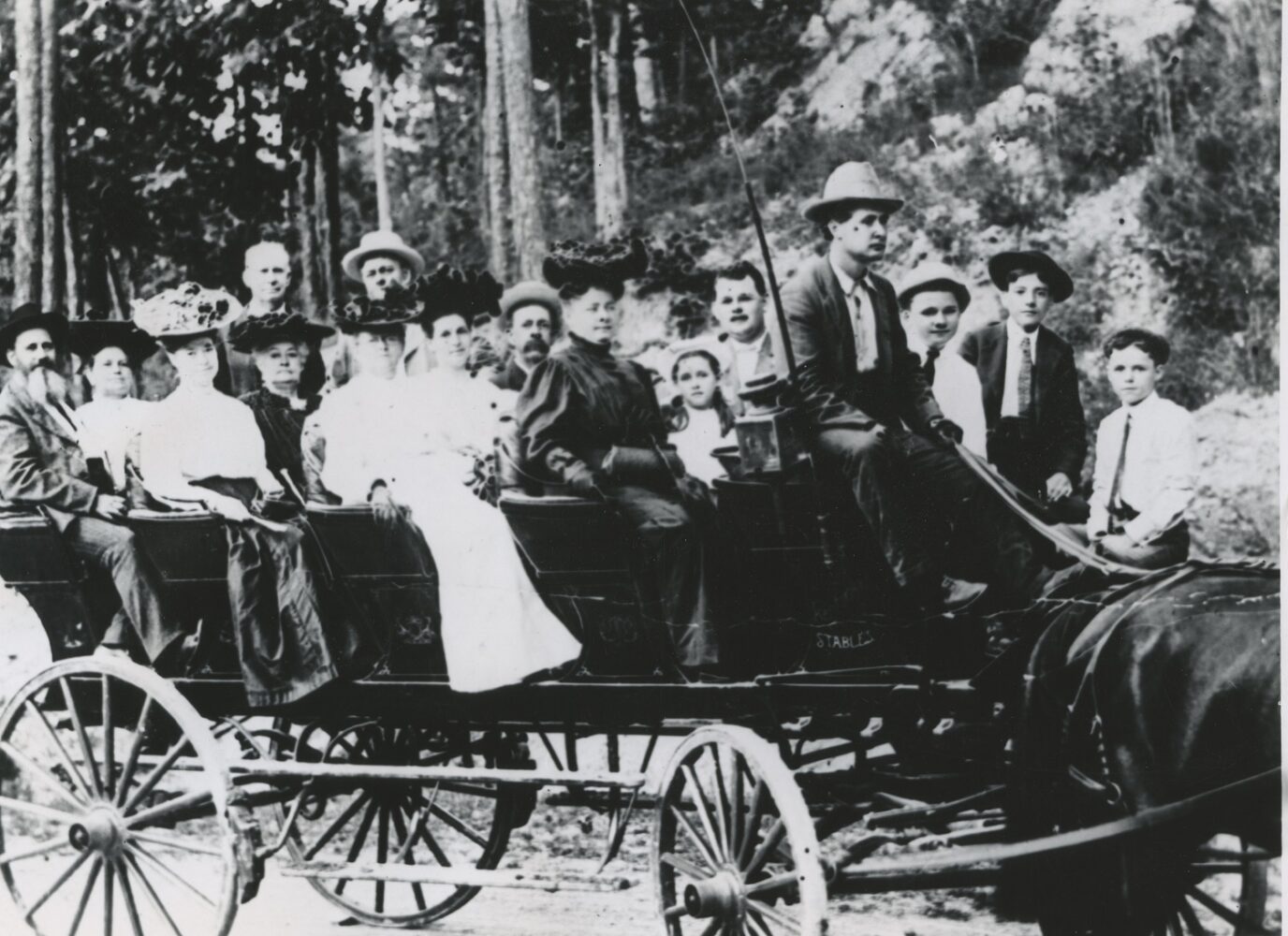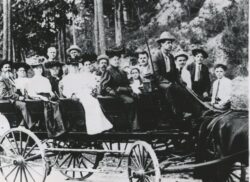Taking the Waters
Belle Cheney Springs—the southern Saratoga
Published: June 1, 2020
Last Updated: June 1, 2023

Photo Courtesy Adelaide Wartelle and Times Picauyne / New Orleans Advocate
A horse-drawn carriage conveys spa-goers to Belle Cheney.
The cold springs about four miles from Cocodrie Lake and thirty-eight miles north of Opelousas were discovered in the early nineteenth century by sportsmen who bathed their dogs in the waters bubbling from the ground. The hunters noticed the dog’s skin diseases disappearing and told others of the spring’s healing properties, wrote Velma Juneau in “Belle Cheney Springs” for the Federal Writers’ Project of the Works Progress Administration in 1936. First called Dog Springs, the springs were later named for a Miss Cheney of Evangeline Parish or Cheneyville, according to conflicting newspaper accounts, one from as early as 1843.
When word got out that springs existed in central Louisiana, people began traveling to the area in hopes that the waters would cure what ailed them. “The Belle Cheney Springs have been opened for visitors during the month, and are already patronized by a handsome company,” wrote the Picayune on July 7, 1851. “[W]ith numerous springs of pure and crystal water, with reputed medicinal virtue as a beverage and baths, together with accommodations of an excellent quality with the view to comfort and pleasure, the proprietors may well prepare for full and worthy patronage. The entire country west of the [Mississippi] river has made this cheerful spot, during the summer months, a resort for their families and friends for several years past.”
There were other springs located in the area—Mountain Bayou Springs and Point-aux-Loups Springs, according to newspaper reports. Several cold springs also existed near Forest Hill and Glenmora. But it was Belle Cheney’s water people demanded to see. The Picayune correspondent who visited the springs in 1850 reported on its miraculous attributes, calling it the “most delightful watering place in Louisiana.”
The correspondent wrote, “The springs, three in number, afford water enough to supply an army, and an analysis of the water from two of them, by one of your New Orleans chemists, proved them not inferior to some of the celebrated Northern springs. Sulphur, iron and magnesia are combined in them, and I can assure you, that so cool is the water, none of your New Orleans gentlemen would think of asking for ice to put in it.” Alexandria’s Louisiana Democrat agreed, claiming in 1859 that the waters were tested and proved to cure “chronic diseases of various kinds.”
The Resort
J. Beauchamp and Joseph Daigle Jr. purchased the property in January 1853. They advertised to the public a resort that included accommodations, bathing areas with spring water, live music, and balls twice a week, as well as opportunities for hunting and fishing from May 1 to November 1. The cost was one dollar per day or twenty-five dollars per month with discounts given for children and servants. (It is unclear whether discounts extended to enslaved domestics.)
To reach Belle Cheney Springs, visitors often took the Texas and Pacific or Morgan Railroad to LeCompte Station for a stay at Daniel Brewer’s Hotel. Brewer owned a livery and transported visitors to the springs by horseback. Noel Larcade also operated “a regular line of jacks between Opelousas and the springs” that took about four or five hours with “a change of horses midway,” wrote the Opelousas Patriot in 1857. In later years, visitors could also access the springs by horse and buggy over a dirt road.
One of the perks of visiting Belle Cheney Springs was the abundant game to be hunted—the copious turkeys in the surrounding woods gave the nearby town its name—and the excellent fishing at Cocodrie Lake. The combination of healing waters, entertainment, and sport lured many prominent families to the region. “During the forties and fifties—the close of the famous antebellum days in Louisiana, the springs formed the meeting place of prominent sugar cane planters,” wrote the Eunice News in a retrospective article in 1937.
During the Civil War, the resort was considered an evacuation site for those wishing to flee Union-occupied areas such as New Orleans. Herman Boehm de Bachellé Seebold, who wrote about the springs in Old Louisiana Plantation Homes and Family Trees, recalled that a Mr. Wilson from Bayou Boeuf near Opelousas proposed to New Orleans residents to relocate to Belle Cheney Springs until the war was over.
Wilson described Belle Cheney as consisting of rustic rental houses surrounding the springs: “There, with the advantage of a healthy situation in a country filled to overflowing with all of the substantial necessities of life, they (New Orleans residents) could pass in peaceful seclusion, the whole period of the war, the faint echoes of which would scarcely penetrate the pine forest which surrounded the springs.” In the late 1800s, transportation to Belle Cheney became more sophisticated and the resort included “summer houses,” a swimming pool, an electric plant to power the resort, and the five springs harnessed by concrete, according to Juneau.
At a gathering at the springs in 1937, Billy Clark, registrar of voters for Evangeline Parish, recalled its heyday after the war. “I can remember the days,” Clark said in an article for the Ville Platte Gazette, “when there were people here by the thousands; by the thousands, I’m telling you! All of this land about the springs were cleared off and two long rows of rudely built houses flanked the approach to Belle Cheney Springs. Right in the middle of the two rows was the big Belle Cheney hotel always packed with tourists and people here for the summer vacations. Folks came here from everywhere within a hundred-mile radius; some came from other states. Horses and buggies, wagons and surries were all we used in those days. Big encampments were pitched right on this very spot for as long as two weeks at the time. Life moved slowly in those days and everybody could enjoy themselves for as long as they wanted.”
The Waters Cease
The resort fell on hard times after the turn of the twentieth century. Crowell & Spencer Lumber Company and Opelousas lawyer John W. Lewis purchased the springs in the hope of initiating its renewal. “For years they were all but forgotten and its buildings have entirely disappeared,” the Eunice News reported of Belle Cheney in 1937. “Some years ago a swimming pool was built in a glen entering the property and today a few visitors occasionally find their way to the springs.”
That year, Lewis was determined to see the resort restored and threw a party at the springs for four hundred people, with many of the guests former spring visitors, such as Clark. Nothing came of his efforts. Today, the springs are reported to have dried up, and all that remains of the resort are concrete foundations located on private property. On Google Maps, the location is still called Belle Cheney Springs, situated off a remote rural road near the Glenmora Turkey Creek Highway.
Freelance journalist Cheré Dastugue Coen is the author of Exploring Cajun Country and Forest Hill, Louisiana: A Bloom Town History. She also writes novels under the pen name of Cherie Claire.
